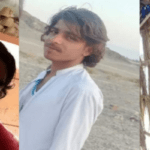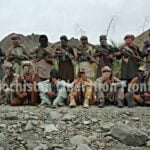Zahedan the capital city of Iranian Balochistan, which is close to the Pakistani province of Baluchistan, was once a major entry point for Sikhs looking for opportunities in Iran.
In the early 1930s, when Reza Shah Pahlavi went on a tour of Iran’s easternmost outposts, bordering India, he saw a group of turbaned men with long flowing beards dressed in white robes. As the story goes, he asked some locals about the turbaned men and was told that they were Zahids, or holy men from Hind. The small town, then called Dozdaab, was renamed Zahedan – the city of holy men.
Dozdaab, or Zahedan, is in the Iranian province of Sistan and Baluchestan (the official spelling in Iran). There is some confusion about the original name of the town. “Dozd” means thief in Farsi, while “aab” means water, which makes some people believe the name meant “water thief”. Others have said the place was at one time notorious for thieves from the part of Balochistan that was under British control. According to this telling, the name is a Baloch word that means outpouring of water.
While some scholars in South Asia and Iran say the Sikh community started coming to the small town in the early 1900s, historical records of the Sikh community in Iran date back to the early 1920s. During the First World War, German and Ottoman agents had penetrated deep into Persia and had their eye on the Indian frontier. Alarmed with the possibility of an invasion of India, the British rulers began constructing a strategic railway link connecting Quetta with Iran. It was at this time that enterprising Sikhs began moving to Dozdaab.
“The railway connecting Quetta to Zahedan has been one of the reasons for the development of the settlement of Dozdaab (Zahedan),” Iranian academic Farideh Okati wrote in a 2015 paper for The Iranian Journal of Language Issues. “The Indians, particularly Sikh workers, building the railway were somehow involved in the establishing and developing of this city by building their houses there and starting new businesses.”
The First Wave
When word of opportunities in what was still called Persia spread to Punjab in the early 1920s, a group of enterprising families from villages near Rawalpindi decided to try their luck in the country. These families would later be joined by relatives who fled the violence that preceded and accompanied the Partition of India in 1947.
Other Sikhs who chose to settle in Zahedan were part of the British Indian Army. When some British forces left Mandatory Iraq for India via Persia, a few years after the end of the First World War, some Sikh soldiers were given trucks as reparations. These decommissioned soldiers then became truckers, transporting fresh produce to Zahedan from Punjab.
“Both my grandfathers, maternal and paternal, were truck drivers bringing vegetables from Punjab into Zahedan,” said Runjeet Singh, who was born in Zahedan and is now a retired professional living in the UK. His parents were born in the Iranian border city and were married in the gurudwara. They left for Tehran when Runjeet Singh was a one-year-old.
“Drivers and traders, who carried or merchandised goods, spices and other products, such as pistachio between Iran and India in the early years of the 20th century, gradually decided to reside in Iran and carry out their jobs in this country,” Okati wrote.
Zahedan’s gurudwara, one of the city’s most unique landmarks, was built in 1921. It was the first Sikh temple in West Asia. Over time, the city became an entry point for Sikhs to Persia, with a significant number of immigrants moving to Tehran.
The community in Zahedan mainly comprised of traders, but some members set up moneylending businesses. Over time, the Sikhs monopolised the auto parts business. In the 1930s, an area in the centre of what was still a small town was known as the Sikh Bazaar.
A 2001 report in The Tribune mentions an entrepreneur named Sahib Singh, who set up the Hind-Iran Bank. The bank had extensive operations in Iran and India, but was liquidated in the late 1950s.
Given the fondness that the Pahlavis had for the community, the Sikhs were granted Iran citizenship without much hassle. Community members still speak of the last Shah with a great degree of admiration and respect. Before Mohammad Reza Pahlavi was overthrown in February 1979, the Sikh community in Iran numbered 5,000.
In Zahedan, the community also managed to develop a good relationship with both the Sistanis and the Baloch. At its peak, the community numbered 500 in the Iranian border town.
Islamic Revolution
The Islamic Revolution, which began in 1978, deeply affected the Sikh community. In December 1979, renowned journalist and author Pranay Gupte was in Zahedan when pitched battles broke out between the Sistanis and the Baloch.
In a report filed for The New York Times on December 24, 1979, Gupte wrote, “The Sikhs were needed by the Baluchis and the Seistanis, and by anyone the Tehran government sent here, because the immigrants from India operate all the automobile spare parts store and other big consumer supplies businesses in town. The Sikhs were also moneylenders and, until the liquor ban ordered by Ayatollah Khomeni, they ran all six wine shops in Zahedan.”
When the violence reached its peak, the community closed its businesses and used the gurudwara as a sanctuary. The community was given assurances by both sides that it would not be harmed.
In his despatch, Gupte wrote that the Sikh community welcomed everyone in the gurudwara, offering visitors “spice-flavoured hot milk and pistachios”. Kirpal Singh, a community leader, told the journalist that the Sikhs stayed away from the local politics of Zahedan. “We number only about 220, and so what choice do we have but to be on good terms with everybody,” Phula Singh, principal of the gurudwara’s school told the journalist. “Our social life is restricted to our own community. We deal with the Baluchis and Sistanis during business hours. But after that we come to our homes and only deal with other Sikhs. It has been like that for more than 50 years.”
Once the fighting came to an end, some Sikhs left Zahedan for Tehran and migrated out of the country. “Some of the Sikhs left this city and also the country just after the revolution because they were afraid of losing their jobs, or that the new situations and conditions of the country might affect their ways of living,” Farideh Okati wrote in her 2015 paper.
More than 20 families stayed behind in Zahedan, but they were subject to new laws and regulations that were imposed by the Islamic regime. Some young Sikhs were conscripted into the army and made to fight in the Iran-Iraq war.
Since the Sikhs in Iran are Iranian citizens, their sons are still obligated to serve in the armed forces for a period ranging from 18 months to two years. However, Sikhism is not recognised by the government as a minority religion. Iran only recognises Christians, Jews and Zoroastrians as official religious minorities. Article 13 of the Iranian Constitution recognises members of these three religious groups as “People of the Book”, and allows them to “exercise religious freedom”.
As per the 2016 census, 40,551 Iranians observed other religions, while 124,572 others did not declare their religion. The Sikh community falls under the category of 165,123 citizens who are not included in the “religious officialdom” of the country. A member of the community in Zahedan who spoke to this writer on the condition of anonymity said Sikhs did not face any kind of discrimination in the country, but added that they discouraged their children from marrying non-Sikhs.
Dwindling Community
At the time of Atal Bihari Vajpayee’s 2001 visit to Iran, Zahedan was home to abut 20 Sikh families. Local estimates in 2021 put it down to 10 families. The city’s gurudwara is still functional and is also used by Indian diplomats and their family members in Zahedan. The consulate, which is located near the gurudwara, provides consular services to four Iranian provinces.
Young adults from the now-miniscule community in Zahedan often look for business opportunities in Dubai or the West, while students seek admission in universities in western countries. There is also a small community of Zahedan Sikhs in the UK.
Research conducted by Iranian scholars suggests that the community is likely to disappear within a couple of generations. A major indication of this is the tiny number of Sikh children in the city. The gurudwara’s school has very few students in its three classrooms, and local reports indicate it is not maintained well. “At the present time, as almost all the younger people have moved to India or other countries either to accomplish their studies or for any other reasons, and have not come back to Zahedan as residents, there have not been any new marriages, and so no more children in the Sikh society to need this school anymore,” Okati wrote.
Efforts are being made by the Sikh diaspora and the Indian government to ensure that the Zahedan gurudwara is looked after. However, with Iran continuing to face Western sanctions and political instability in the wider neighbourhood, Zahedan is a far cry from the days when Punjabis believed it was a place where “money poured from the sky”. It’s only a matter of time before the Sikh community vanishes from the city that got its present name because of them.
Ajay Kamalakaran is a writer and independent journalist, based in Mumbai. He is a Kalpalata Fellow for History & Heritage Writings for 2021.
Support our journalism by contributing to Scroll Ground Reporting Fund.
https://scroll.in/magazine/1012298/when-a-small-sikh-community-thrived-in-an-iranian-border-town
This post was created with our nice and easy submission form. Create your post!




Comments